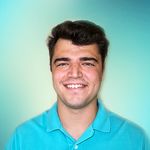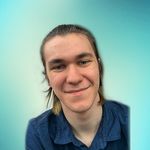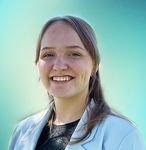The 2021 SPS Intern Symposium - Friday, August 6, 2021 11 AM -2:00 PM EDT - Society of Physics Students
←
→
Page content transcription
If your browser does not render page correctly, please read the page content below
2021 SPS Internship Symposium
The 2021 SPS Intern Symposium
Friday, August 6, 2021
11 AM -2:00 PM EDT2021 SPS Internship Symposium
Welcome Remarks —11:00 AM EDT
Michael H. Moloney, AIP Chief Executive Officer
Jim Borgardt, Sigma Pi Sigma President
Brad R. Conrad, SPS & Sigma Pi Sigma Director
Presentations —11:10 AM EDT
Jess Zeldes
Society of Rheology/Soft Matter Kitchen
Haverford College
Bringing the Lab Home: The Physics of Cooking at the Soft Matter Kitchen
Presentation Time: 11:10 AM EDT
Rheology, the study of the flow and deformation of complex materials, can feel esoteric, but it plays a crucial role in our everyday lives.
Many of the things that make our favorite foods distinct and interEDTing are due to important rheological properties. In this talk, I will give
a brief explanation of the mission of the Soft Matter Kitchen program, which seeks to engage people with the fields of rheology and soft
matter physics through food. Then, I’ll give a couple of examples of educational content I worked on this summer. You’ll learn what makes
mayonnaise stable, how bread dough can be used to visualize the Weissenberg effect, and how to use the principles of rheological design
to emulate one of the biggEDT food trends of the past few years. Along the way, I’ll explain a few of the important properties used to describe
non-Newtonian fluids, and explain why we care about these complex flows.
Rob Gauna
NIST Gaithersburg
Massachusetts Institute of Technology
Subsurface Structure Characterization Using Remote Bias EFM
Presentation Time: 11:18 AM EDT
Scanning Kelvin Force Microscopy (SKFM) is a form of noncontact atomic force microscopy (nc-AFM), more specifically an electrostatic
force microscopy (EFM) technique, which makes use of the electrostatic forces between the cantilever probe tip and the sample to image
and characterize the sample properties at sub nanometer scales. Because electrostatic forces occur over long distances SKFM/EFM can
be used to characterize subsurface structures, making it useful for imaging/tEDTing 3D integrated circuits. SKFM/EFM is used today for
measuring circuit properties such as dielectric constant, accumulated charges, and conductivity variations. I will present on my remote bias
EFM simulations which focused on characterizing subsurface aluminum strips embedded in Silicon Dioxide (SiO2) and Hafnium substrates
with varying probe tip geometries.
Karthik Rao
NIST Gaithersburg
Texas A&M University
Profiling the Shape of Electrostatic Force Microscopy Probes Using Finite Element Simulations
Presentation Time: 11:26 AM EDT
Electrostatic force microscopy (EFM) is a non-contact atomic force microscopy technique which gives access to electrostatic and electronic
surface properties of samples with high precision. This technique involves applying a bias voltage to excite a cantilever oscillation, which
oscillates with an amplitude that depends on the electrostatic force interaction between the probe tip and sample. COMSOL Multiphysics
is a finite element analysis and Multiphysics simulation software platform that allows conventional physics-based user interfaces. Using
this software, simulations of EFM with different probe shapes were performed in both 2-D and 3-D. The results of these simulations will be
compiled into a database that will be used in determining unknown probe shapes in the future.2021 SPS Internship Symposium
Julia Bauer
AIP FYI Science Policy News
Davidson College
Science Policy and the Mitigation of Climate, Energy, and Health Issues
Presentation Time: 11:34 AM EDT
Worsening climate change has necessitated greater investment in monitoring technologies, while outdated energy R&D policies have
impeded marginalized communities’ ability to access reliable energy sources. Underlying both issues is science policy, particularly as it
concerns congressional appropriations to federal science agencies. During my presentation, I will discuss the importance of current funding
gaps in three areas of science policy, as well as how policymakers are attempting to remediate those gaps. The presentation will address the
House Science Committee’s work to improve satellite technology for monitoring wildfires, energy equity policy, and the uncertain future of
DOE’s low-dose radiation research program.
Madison Brewer
AIP Physics Today
University of Pittsburgh
Writing about Research: Physics Today’s Publishing Process
Presentation Time: 11:42 AM EDT
When it comes to publishing, there is a lot of behind-the-scenes work—writing isn’t the only thing to be done. There’s also research and
interviewing and editing, processes that require at least five people in addition to the writer. I have gotten to see this firsthand as well as
take part in it this summer. Much like science, writing is a collaborative process. And at science publications like Physics Today, writers and
researchers must work together to create an accurate and exciting story. I will outline the process of composing a story, from finding the
research to posting it on the website. Other steps include interviewing, writing, and editing. This presentation will focus on “Jerk causes
energy loss on the loop-the-loop,” an article I wrote for the Physics Today website about the iconic demonstration.
Kirk Kleinsasser
APS Careers
Lycoming College
Employment Trends: Desirable Applicant Skills of Physics Degree Holders
Presentation Time: 11:50 AM EDT
Many undergraduates in physics see graduate school as the ultimate goal of their education. However, the majority of physics bachelor’s
find employment outside of academia. Physics training encompasses a diverse set of skills—physics degree holders at all levels are highly
employable in the private and government sectors, which may require a different type of skill set than academia. To invEDTigate this point,
my work this summer has focused on extracting desirable skills based on sector and degree requirements from the data available to APS.
Over the course of my internship, I developed a program to collect and process APS Job Board postings, exporting common keywords that
may hold significance, based on a variety of factors. The board pools job postings in various job sectors from APS and partner societies,
including Physics Today, SPS, AAPM, and IEEE Computing. In collaboration with my mentor, I took this data and found the most relevant
keywords to analyze. In this presentation, I will explain my approach and present the results of the APS job board analysis.2021 SPS Internship Symposium
Hannah Wistrand
APS Public Engagement
Colorado School of Mines
Engaging the Public to Fight the Spread of Scientific Misinformation
Presentation Time: 11:58 AM EDT
As I started my time at APS, the world was beginning to navigate through the next steps of a global pandemic, and our country was
leaving behind a period of widespread misinformation and mistrust. During a time when the public needs to know which sources they
can trust to make decisions that will directly affect their health, the American Physical Society has set out to help combat the spread of
scientific misinformation. To determine the most effective strategy for the role APS and its members play in this trying time, a trial campaign
was developed to train APS members in effective communication skills. The intention was that these members would discuss commonly
misinterpreted scientific topics with their friends and neighbors, then report to the APS team about their experiences. Moving forward from
this trial and feedback, APS will learn to define what an “effective strategy” means to their organization and members, as well as be better
equipped to continue their pursuits of political and social advocacy. This presentation sets out to discuss the methods of engagement and
analysis being used by APS for this goal.
Zeynep Tuna
APS Education & Diversity
Bowdoin College
From Data and Categories to a More Diverse Physics Education
Presentation Time: 12:06 PM EDT
In light of a global pandemic, the Black Lives Matter movement, and the efforts to stop Asian and Pacific Islander violence, it is more
important now than ever to focus on making our physics community more diverse and inclusive. In order to succeed in this mission, we must
better understand the rapidly changing demographics of the field of physics. During my internship at APS, I had the opportunity to analyze
the national physics education statistics based on race, ethnicity, and gender, observe improvements made in diversity and inclusion in
physics year-by-year, and realize the further changes and improvements we need to make. This presentation will focus on how diversity
and inclusion data for physics degrees is obtained, categorized, and presented so that the institutions and the community can make active
decisions to reach racial and gender parity in the field of physics.
Break — 12:15 PM EDT
Gina Pantano
NASA Goddard Space Flight Center
University of Tampa
High-Fidelity Simulations of EXCLAIM Mission Data
Presentation Time: 12:25 PM EDT
The EXperiment for Cryogenic Large-Aperture Intensity Mapping (EXCLAIM) is a balloon-borne mission designed to invEDTigate why
the star formation rate declined around redshift z ~ 2, despite the continued clustering of dark matter. EXCLAIM will use a relatively new
observational technique, known as line intensity mapping, to measure the integrated sky emission of carbon monoxide and singly ionized
carbon line transitions at different redshifts. EXCLAIM will analyze the evolution of these tracers by integrating these snapshots and cross
correlating our observations with galactic surveys, which will allow us to provide a more detailed reconstruction of star formation patterns.
During my presentation, I present high-fidelity simulations of these three-dimensional intensity maps based on current EXCLAIM models
and mission data.2021 SPS Internship Symposium
Joseph Watson
NASA Goddard Space Flight Center
McMurry University
Instrument Design and Implementation for Cryogenic Balloon Borne Telescope
Presentation Time: 12:33 PM EDT
EXCLAIM’s mission is to use a cryogenic balloon-borne telescope to record a three-dimensional intensity map in the microwave
electromagnetic range corresponding to carbon monoxide and carbon ion emission to study galaxy evolution and star formation. My work
focused on the spectrometer package and readout, taking a preliminary design meeting mission requirements to a complete mechanical
design that has been sent to machine shops for fabrication. These tasks have involved challenging special, thermal, magnetic, and electrical
constrains. After everything was verified, drawings of highly complex parts were produced and sent to machine shops for quotes and future
purchase.
Maura Shapiro
AIP Center for History of Physics and Niels Bohr Library & Archives
University of Pittsburgh
Carbon-Foote Print: Eunice Newton Foote and her Forgotten Discovery
Presentation Time: 12:41 PM EDT
In 1856, Eunice Newton Foote, an American scientist, inventor, and suffragette, prophesied climate change. She discovered the heat-absorbing
properties of water vapor and carbon dioxide by recreating atmospheric conditions in glass jars and exposing them to sunlight. In her paper
“On the heat in the sun’s rays” she declared “an atmosphere of this gas [carbon dioxide] would give to our earth a high temperature.” Until
the past decade, however, credit for this groundbreaking discovery was awarded to John Tyndall, a famous Irish physicist. Today, amidst
record-breaking heatwaves, droughts, and floods, we experience her conclusion firsthand, as climate change impacts our daily lives. Despite
her pioneering contributions and insight, her work was ignored, and her name forgotten. This talk will discuss her work, the factors that
contributed to suppressing her discovery, and my experience researching her for teaching guides and a Physics Today Online article.
Alan Wright
American Association of Physics Teachers
Purdue University
Summer Break for Teachers
Presentation Time: 12:49 PM EDT
There is a lot more to being a teacher than many realize. Teachers are always improving their classroom skills, learning new content,
and collaborating with other teachers to get new ideas. AAPT provides plenty of opportunities for teachers to engage in these ways, and
this summer I had the opportunity to be a part of several activities AAPT is involved with, including a quantum computing workshop,
undergraduate discussion panel, and initiative to promote diversity in physics. In this presentation I will give an overview of some of the
important and impactful activities in which I participated and how these activities relate to my goals of becoming a physics teacher.
Noah Johnson
AIP SPS SOCK
New York University
A Summer of Outreach: Captivating Kids with Physics
Presentation Time: 12:57 PM EDT
Outreach is a fundamental part of the Society of Physics Students (SPS) and the most common activity chapters do. Being the SOCK Intern,
my responsibilities not only covered the SOCK program, but a whole range of outreach. In this talk I will outline new physics demonstrations2021 SPS Internship Symposium
for students of all ages, my work around the acoustic based SOCK (expanded) and the Psi* Program, which formally joined SPS as part of
the outreach toolkit. We will go over other side projects as well, including physics jeopardies and running the SPS Demo Competition.
Casey Roepke
AIP Mather Policy - NIST
Mount Holyoke College
Schrödinger’s Cat: A Superposition of Funding Contingencies
Presentation Time: 1:05 PM EDT
The first year of a new administration brings new energy to government, as the President signs new legislation, staff’s
political appointments, and crafts their political priorities. My role as an AIP Mather Policy Intern at the Office of Advanced
Manufacturing (OAM) in the National Institute of Standards and Technology (NIST) allowed me to explore the nuance in crafting
and implementing science policy to support advanced manufacturing innovation and competitiveness in the first year of a new
administration. OAM is constantly creating contingency plans to deal with legislative uncertainties, and we often treat a piece
of legislation as simultaneously “alive” and “dead” (just like Schrödinger’s cat) to prepare for different science policy outcomes.
In this presentation, I will draw on my internship experience — from advisory groups to education budgets, from outreach and
engagement strategies to reading Congressional bills — to demonstrate the fast-paced, intense, and fulfilling environment of
science policy at NIST.
Guido Dominguez
AIP Mather Policy
Pomona College
The Marriage of Science and Politics
Presentation Time: 1:13 PM EDT
The American political scientist Don K. Price once said that “The union of the political and scientific EDTates is like a marriage, it will not
be improved if the two become like each other, but only if they respect each other’s quite different needs and purposes.” As the AIP Mather
Policy Intern for the House Committee on Science, Space, and Technology, I had the great privilege to witness this union on a daily basis.
Through the countless hearings, briefings, reports, and summaries I attended and prepared it was clear to me that science is once again at
the forefront of the nation’s priorities. This summer alone the committee has shepherded the passage of the National Science Foundation for
the Future Act by the House, led the way for an increase in NASA’s budget of $1.5 billion, and held hearings on some of the most important
scientific challenges of our time. There is still much more to do and room for a greater utilization of and respect for science throughout the
policy process, but as Don K. Price masterfully concluded when talking about this marriage, “No great harm is done if in the meantime they
quarrel a bit.” In my talk, I’ll be giving an overview of the process behind these achievements and more, as well as why I’m more hopeful than
ever about the marriage between science and politics.
Intern Outreach Demo — 1:25PM EDT
Noah Johnson, AIP SPS SOCK Intern
Closing Remarks — 1: 35PM EDT
Brad R. Conrad, SPS & Sigma Pi Sigma Director
Kayla Stephens, SPS Assistant DirectorSPS would like to thank the following mentors for their time and
dedication to the 2021 SPS Interns
Mitch Ambrose, AIP FYI Science Policy Communications
Andrew Grant & Christine Middleton, AIP Physics Today
Evan Brooks, United States House of Representatives
Joseph Kopanski, Robert Rudnitsky & Lisa Fronczek, NIST
Melanie Mueller, Audrey Lengel, & Corrine Mona,
AIP Niels Bohr Library & Archives
Gregory Good & Joanna Behrman, Center for History of Physics
Arif Nelson, Society of Rheology
Claudia Fracchiolla, Midhat Farooq, & Renee-Michelle Goertzen,
American Physical Society
Eric Switzer & Thomas Essinger-Hileman, NASA Goddard Space Flight Center
Mark Hannum, American Association of Physics Teachers
Brad R. Conrad, AIP Society of Physics Students
All those who support SPS and Sigma Pi Sigma through donations
SPS Internships are made possible by the generous support of AIP and the host institutions, the John &
Jane Mather Foundation for Science and the Arts, AIP, AAPT, APS, The Optical Society, Society of Rheology,
NASA, NIST, and individual contributions from members of the physics and astronomy community. For more
information about the SPS and supporting its programs, please visit donate.aip.org.You can also read



























































